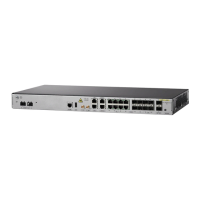1-22
Cisco ASR 901 Aggregation Services Router Command Reference Guide
OL-26031-07
Chapter 1 CLI Command Reference
class (policy-map)
class (policy-map)
To specify the name of the class whose policy you want to create or change or to specify the default class
(commonly known as the class-default class) before you configure its policy, use the class command in
policy-map configuration mode. To remove a class from the policy map, use the no form of this
command.
class {class-name | class-default}
no class {class-name | class-default}
Syntax Description
Command Default No class is specified.
Command Modes Policy-map configuration (config-pmap)
Command History
Usage Guidelines
Policy Map Configuration Mode
Within a policy map, the class (policy-map) command can be used to specify the name of the class whose
policy you want to create or change. First, the policy map must be identified.
To identify the policy map (and enter the required policy-map configuration mode), use the policy-map
command before you use the class (policy-map) command. After you specify a policy map, you can
configure policy for new classes or modify the policy for any existing classes in that policy map.
Class Characteristics
The class name that you specify in the policy map ties the characteristics for that class—that is, its
policy—to the class map and its match criteria, as configured using the class-map command.
When you configure policy for a class and specify its bandwidth and attach the policy map to an
interface, class-based weighted fair queueing (CBWFQ) determines if the bandwidth requirement of the
class can be satisfied. If so, CBWFQ allocates a queue for the bandwidth requirement.
When a class is removed, available bandwidth for the interface is incremented by the amount previously
allocated to the class.
The maximum number of classes that you can configure for a router—and, therefore, within a policy
map—is 64.
class-name Name of the class to be configured or whose policy is to be modified. The
class name is used for both the class map and to configure a policy for the
class in the policy map.
class-default Specifies the default class so that you can configure or modify its policy.
Release Modification
15.1(2)SNG Support for this command was introduced on the Cisco ASR 901 router.

